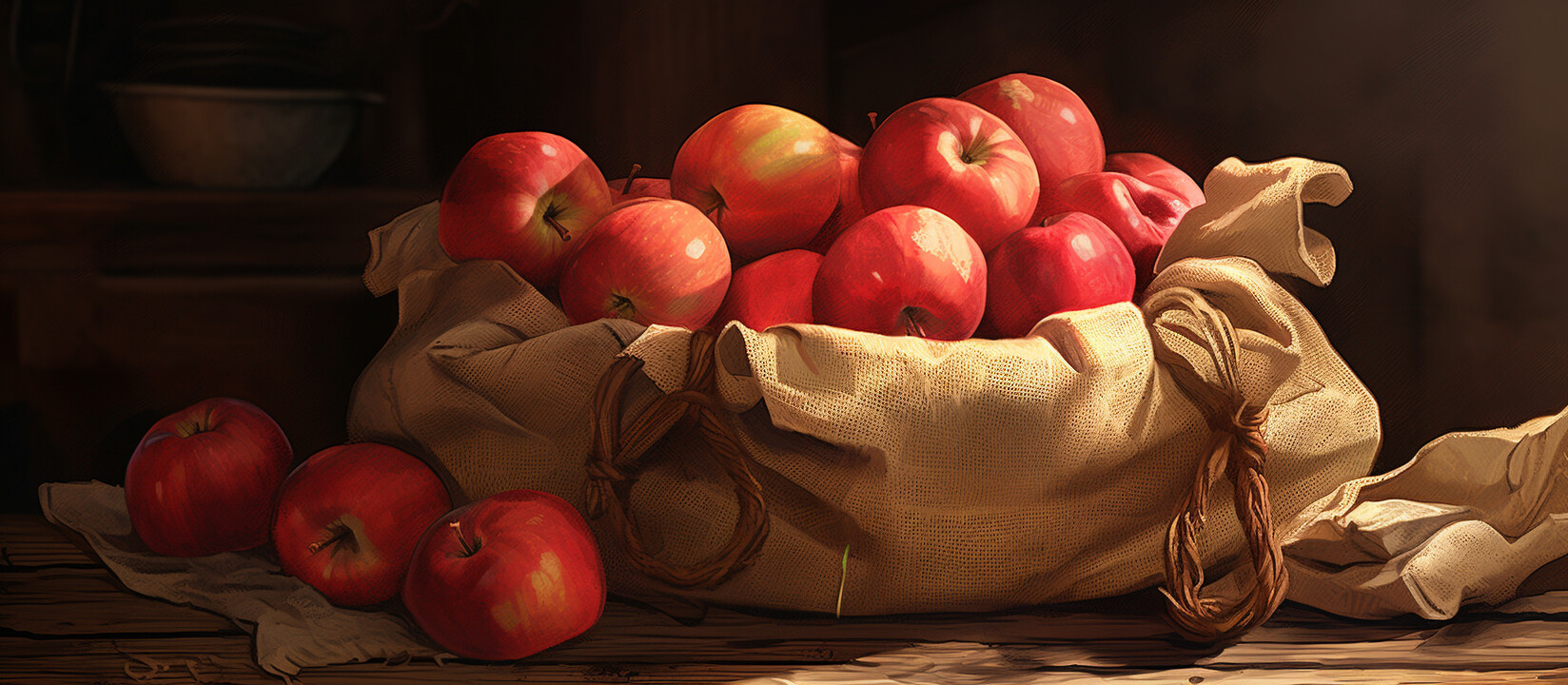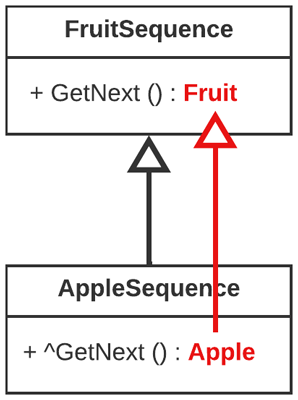108. Covariance#
We’ve introduced the concept of variance and it’s now time to understand the specific type of variance known as covariance.
Key point
If you ask for a bag of fruits and I give you a bag of apples, you shouldn’t be upset.
Imagine that you were expecting a bag of fruit but get a bag of apples. A bag of apples is still a bag of fruit. Anything you had intended to do with the fruits, you can do to the apples. This illustrates the concept of covariance.

Fig. 108.1 Just like a bag of apples is a bag of fruit, covariance follows the natural hierarchy of types.#
If the contents of a bag is covariant, then a bag of apples is a subtype of a bag of fruit. Let’s dissect what this means and why it makes sense.
Understanding covariance with generics#
If a generic type I is parameterized over the type parameter T, denoted as I<T>, and if T is covariant, then the usual ordering of types is maintained.
This means that subtypes may use more specific types than what’s used in the supertype.
For example I<Apple> would be a subtype of I<Fruit> if Apple is a subtype of Fruit.
Definition
If A is a subtype of B and if T is covariant in I<T> then I<A> is a subtype of I<B>.
Let’s use generics to understand covariance.
Assume that we have the two classes Apple and Fruit and that the former is a subtype of the latter.
class Fruit {}
class Apple : Fruit {}
In the example below, a variable of type IEnumerable<Fruit> is assigned a value of type IEnumerable<Apple>.
This is valid since IEnumerable<Apple> is a subtype of IEnumerable<Fruit> which means that the type can be implicitly upcast.
It is a subtype since T is covariant in IEnumerable<T> and Apple is a subtype of Fruit.
IEnumerable<Apple> apples = new List<Apple>();
IEnumerable<Fruit> fruits = apples;
The example shows that if you need a series of fruits then a series of apples will do just fine.
Why is this compile-time type-safe?
The IEnumerable<T> interface only exposes a single method which returns IEnumerator<T> which in turn allows you to loop through the items in the collection, but not modify them.
Tip
IEnumerable<T> is essentially a ‘producer’ of elements of type T but never a ‘consumer’ of them.
It only returns elements of type T as output, but never takes them as input.
In essence, when you specify that you need an IEnumerable<Fruit>, you’re saying that you need a sequence that will produce elements that are, at minimum, of type Fruit. An object of type IEnumerable<Apple> fits this criterion because it produces elements that are always of type Apple, which is a subtype of Fruit.
Therefore, IEnumerable<Apple> can be safely treated as IEnumerable<Fruit> without causing any type errors.
Understanding covariance with classes#
Before we leave this chapter, let’s also look at roughly the same problem but without generics.
In the code below we can see how a subtype called AppleSequence inherits from FruitSequence and overrides the method that returns the next item in the sequence.
class Fruit { }
class Apple : Fruit { }
class FruitSequence
{
public virtual Fruit GetNext()
=> new Fruit(); // Placeholder implementation.
}
class AppleSequence : FruitSequence
{
public override Apple GetNext()
=> new Apple(); // Placeholder implementation.
}
This code is valid C# due to a feature known as covariant return types but more on that in its own chapter.
What we should emphasize is that the return type of the subtype’s method marked as override is a subtype of the return type of the supertype’s method marked as virtual.
Note
Why is it type safe? The GetNext() method in both FruitSequence and AppleSequence acts as a ‘producer’ of elements, much like the GetEnumerator method of IEnumerable<T>. It produces elements of a specific type as output but doesn’t consume any elements as input. This is why it is type safe to let the method’s return type be covariant.

Fig. 108.2 This UML class diagram is annotated with a red arrow to highlight the concept of covariance. Consistent with the natural type hierarchy of the method return types, where Apple is a subtype of Fruit, the arrow between the containing types AppleSequence and FruitSequence also follows this hierarchy, signifying that AppleSequence is a subtype of FruitSequence.#
Consider the UML class diagram in Fig. 108.2 where the arrows indicate subtype relationships. The arrow from AppleSequence to FruitSequence signifies that AppleSequence is a subtype of FruitSequence. The arrow from Apple to Fruit is not standard UML but indicates that Apple is a subtype of Fruit.
The fact that both arrows point in the same direction tells us that we’re dealing with covariance.
Up next#
In the next chapter we will learn about contravariance where the type relationships are inverted. While covariance allows us to use a more specific type where a more general one is expected, contravariance allows us to use a more general type in place of a more specific one.